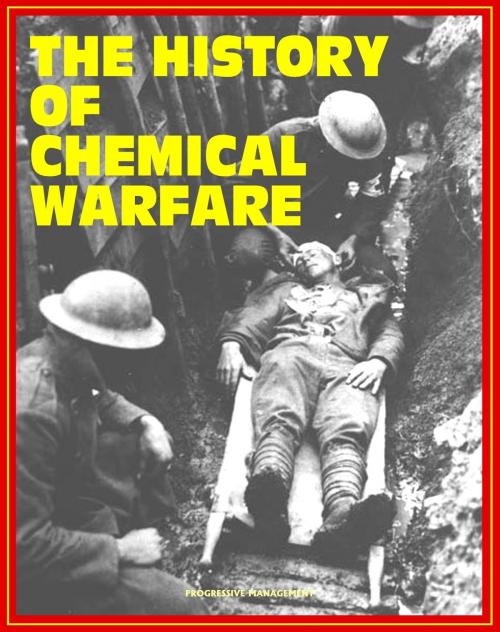The History of Chemical Warfare - From World War I to Iraq, Terrorist Threats, Countermeasures and Medical Management, CWC Treaty and Demilitarization (Medical Aspects of Chemical Warfare Excerpt)
Nonfiction, Social & Cultural Studies, Political Science| Author: | Progressive Management | ISBN: | 9781466100312 |
| Publisher: | Progressive Management | Publication: | July 27, 2011 |
| Imprint: | Smashwords Edition | Language: | English |
| Author: | Progressive Management |
| ISBN: | 9781466100312 |
| Publisher: | Progressive Management |
| Publication: | July 27, 2011 |
| Imprint: | Smashwords Edition |
| Language: | English |
From the much-referenced and highly acclaimed Textbooks of Military Medicine series, this excerpt from the Medical Aspects of Chemical Warfare textbook provides a thorough and compelling history of chemical warfare, with on-scene accounts of the horrors inflicted by these fearsome weapons.
These chapters offer great depth concerning the history of chemical warfare and the basic principles of chemical warfare. "History of Chemical Warfare" takes a broad view of the historical context and significant events in the field. "History of the Chemical Threat" breaks the 20th century down into decade-long segments and provides a fresh perspective on prior military and political developments. "The Medical Aspects of Medical Management" chapter has radically changed over the years and presents this history from multiple perspectives. It includes detailed accounts of the chemical warfare management experience in the United States, as well as a revealing exploration of British, Canadian, French, Russian, and German experiences.
The US military has been concerned with the risk of chemical warfare for decades. By the end of the twentieth century, however, scenarios for the use of chemical weapons expanded beyond the battlefield as terrorist organizations began employing them against civilian populations. This development is not surprising, given that a great percentage of the world's population now has the ability and knowledge to develop weapons of mass destruction, particularly chemical weapons.
In 1995, Aum Shinrikyo, a well-funded Japanese religious cult with chemical expertise, released sarin, a deadly nerve agent, in five separate subway cars in downtown Tokyo. The attack not only caused panic, but also overwhelmed the medical response system. In Baghdad, Iraq, on May 18, 2004, a small amount of sarin was dispersed by a shell that exploded near a US military convoy, and on April 6, 2007, a chemical, first weaponized during World War I, reappeared when a suicide bomber in Baghdad detonated a truck loaded with chlorine gas, killing 20 people and wounding 30 others.
Although the events of September 11, 2001, did not involve chemical weapons, they did underscore terrorists' willingness to use unconventional weapons and shocked the United States into awareness of its own vulnerability to terrorist attacks. The use of chemical agents by terrorist groups is now a recognized threat to the American population and to US troops deployed abroad. We know terrorist groups have the knowledge and the financial support to design and disperse chemical weapons. Also, as our world becomes more highly industrialized, chemicals, some of which are highly toxic, are used in numerous manufacturing processes; the world's population is at risk of exposure to these lethal chemicals through their inadvertent release from manufacturing plants and accidents during their transportation or intentional release by terrorists.
This is a privately authored news service and educational publication of Progressive Management. For over a quarter of a century, our news, educational, technical, scientific, and medical publications have made unique and valuable references accessible to all people. Our e-books put knowledge at your fingertips, and an expert in your pocket!
From the much-referenced and highly acclaimed Textbooks of Military Medicine series, this excerpt from the Medical Aspects of Chemical Warfare textbook provides a thorough and compelling history of chemical warfare, with on-scene accounts of the horrors inflicted by these fearsome weapons.
These chapters offer great depth concerning the history of chemical warfare and the basic principles of chemical warfare. "History of Chemical Warfare" takes a broad view of the historical context and significant events in the field. "History of the Chemical Threat" breaks the 20th century down into decade-long segments and provides a fresh perspective on prior military and political developments. "The Medical Aspects of Medical Management" chapter has radically changed over the years and presents this history from multiple perspectives. It includes detailed accounts of the chemical warfare management experience in the United States, as well as a revealing exploration of British, Canadian, French, Russian, and German experiences.
The US military has been concerned with the risk of chemical warfare for decades. By the end of the twentieth century, however, scenarios for the use of chemical weapons expanded beyond the battlefield as terrorist organizations began employing them against civilian populations. This development is not surprising, given that a great percentage of the world's population now has the ability and knowledge to develop weapons of mass destruction, particularly chemical weapons.
In 1995, Aum Shinrikyo, a well-funded Japanese religious cult with chemical expertise, released sarin, a deadly nerve agent, in five separate subway cars in downtown Tokyo. The attack not only caused panic, but also overwhelmed the medical response system. In Baghdad, Iraq, on May 18, 2004, a small amount of sarin was dispersed by a shell that exploded near a US military convoy, and on April 6, 2007, a chemical, first weaponized during World War I, reappeared when a suicide bomber in Baghdad detonated a truck loaded with chlorine gas, killing 20 people and wounding 30 others.
Although the events of September 11, 2001, did not involve chemical weapons, they did underscore terrorists' willingness to use unconventional weapons and shocked the United States into awareness of its own vulnerability to terrorist attacks. The use of chemical agents by terrorist groups is now a recognized threat to the American population and to US troops deployed abroad. We know terrorist groups have the knowledge and the financial support to design and disperse chemical weapons. Also, as our world becomes more highly industrialized, chemicals, some of which are highly toxic, are used in numerous manufacturing processes; the world's population is at risk of exposure to these lethal chemicals through their inadvertent release from manufacturing plants and accidents during their transportation or intentional release by terrorists.
This is a privately authored news service and educational publication of Progressive Management. For over a quarter of a century, our news, educational, technical, scientific, and medical publications have made unique and valuable references accessible to all people. Our e-books put knowledge at your fingertips, and an expert in your pocket!















